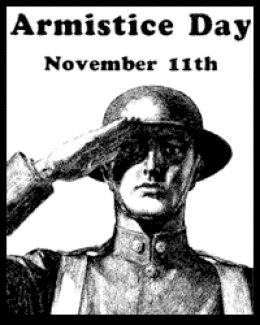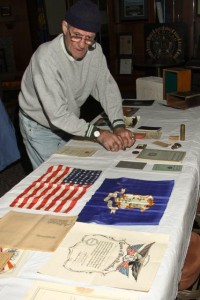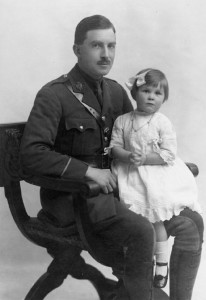 November 11th is called Veterans Day in the United States, a federal holiday in honor of all military veterans, living and dead. It only became such in 1954, however. It started out as Armistice Day, a day to honor the fallen soldiers of World War I on the anniversary of the official cessation of hostilities when Germany signed an armistice on the 11th hour of the 11th day of the 11th month of 1918. Woodrow Wilson proclaimed the first Armistice Day on November 11, 1919. Four days earlier King George V had declared November 11th would thenceforth be observed as Remembrance Day in honor of the members of the armed forces who had been killed in the Great War.
November 11th is called Veterans Day in the United States, a federal holiday in honor of all military veterans, living and dead. It only became such in 1954, however. It started out as Armistice Day, a day to honor the fallen soldiers of World War I on the anniversary of the official cessation of hostilities when Germany signed an armistice on the 11th hour of the 11th day of the 11th month of 1918. Woodrow Wilson proclaimed the first Armistice Day on November 11, 1919. Four days earlier King George V had declared November 11th would thenceforth be observed as Remembrance Day in honor of the members of the armed forces who had been killed in the Great War.
I’m going to kick it old school in today’s entry because I think it’s a shame the US doesn’t have a day set aside to remember all the lives lost in World War I. Our involvement came late and the battlefields were distant. As a nation we didn’t pay the same cost Europe did, although many Americans paid with life and limb, so once World War II eclipsed the horror of our first foray into global war, it was easier for us to forget. So here’s just a little bit of remembrance of the original veterans of Veterans Day.
 The members of the American Legion Hayes-Velhage Post 96 in West Hartford, Connecticut, veterans all, were recently reminded of their forefathers who fought in World War I. Post commander Andrew Battistoni was trying to get the cornerstone of their original building to stop from wobbling on its display table. The old building had been demolished when a new retail and residential complex was built in 2007. They meant to install the original cornerstone in the new building, but that didn’t happen so instead they put it on display. While Battistoni was chipping away at some uneven concrete that was making the cornerstone wobble, a little copper box fell out. It was a World War I time capsule.
The members of the American Legion Hayes-Velhage Post 96 in West Hartford, Connecticut, veterans all, were recently reminded of their forefathers who fought in World War I. Post commander Andrew Battistoni was trying to get the cornerstone of their original building to stop from wobbling on its display table. The old building had been demolished when a new retail and residential complex was built in 2007. They meant to install the original cornerstone in the new building, but that didn’t happen so instead they put it on display. While Battistoni was chipping away at some uneven concrete that was making the cornerstone wobble, a little copper box fell out. It was a World War I time capsule.
A newspaper clipping from The Hartford Courant gave a sense of how long the capsule rested, sealed in concrete. The article was dated June 15, 1929 — more than 82 years.
Along with the clipping were items from WWI veterans from West Hartford. For example, there was a cigarette lighter from Waldo C. Hayes and a watch that belonged to Francis B. Velhage — from whom the post draws its name. In all, 23 West Hartford soldiers lost their lives in WWI, and many of them were represented inside the copper box. There were Bibles and medals, donated by the families for inclusion in the capsule.
Neither Battistoni, a member of the American Legion post for 15 years, nor anyone else in the organization knew anything about it. The fact that they kept the cornerstone was a complete coincidence. The capsule won’t be forgotten now, though. It will go on display at the American Legion Hayes-Velhage Post 96 building on Veterans Day. After that, Battistoni plans to take the capsule and the artifacts it contained to local schools to teach them about West Hartford’s sons who fought in World War I.
Not everyone wants to be reminded of the horrors of that war. A team of French archaeologists is excavating the Killian Shelter, an underground tunnel near the town of Carspach in the Alsace-Lorraine region on the border with Germany. The 410-feet-long tunnel housed German soldiers from the 6th Company of the “Reserve Infanterie Regiment 94” and was destroyed by shelling in March of 1918. Only 13 of the 34 dead were retrieved at the time because it was too dangerous to go any further into the tunnel. The 21 remaining are still in there along with their gear and personal belongings.
When the battlefield at Fromelles was excavated in 2008 and the remains of 250 soldiers found, there was an avalanche of attention paid. People all over the Commonwealth volunteered DNA samples to help identify the remains. The dead of the Killian Shelter, on the other hand, have barely made the news at all in Germany.
“Britain, France and Belgium still refer to it as the Great War, but our memory of it is totally buried by World War II with the Holocaust, the expulsion from the east, the Allied bombardment,” Fritz Kirchmeier, spokesman for the German War Graves Commission, told SPIEGEL ONLINE. “World War I plays only a minor role in the German national memory.”
The Commission is holding out little hope that it will be able to track down the families of the dead.
“We haven’t reached anyone yet and it will be very hard, as you can imagine, given the time that has lapsed,” said Kirchmeier. “It’s a difficult business that involves contacting local registry offices.”
It would not appear to be an insurmountable problem, though, if the public interest was there. The names and dates and places of birth of all the 21 soldiers are known. Their dog tags have been found. The soldiers include Musketeer Martin Heidrich from Schönfeld, aged 20, Private Harry Bierkamp, born Jan. 18, 1896 in Hamburg, and Lieutenant August Hütten from Aachen, aged 37.
A memorial stone bearing their names stands in the nearby German war cemetery of Illfurth. The Commission will rebury the bodies in the cemetery unless it manages to contact descendants and they decide to have the remains repatriated to Germany.
They don’t even need DNA, just a thorough records search and even that seems too exhausting a prospect. That saddens me. I would want to know if my grandfather’s remains were found.
To close with a more positive note of remembrance, Britain’s Imperial War Museum has an outstanding website dedicated to the upcoming centennial of the start of World War I. There are podcasts tracing each step of the war with interviews with veterans, updates on museum exhibits, World War I in the news and archaeological discoveries like the current excavation of the infamous Gallipoli battlefield in Turkey.
 Now they’ve added a Flickr account called Faces of the First World War to help people put some faces to the names engraved on memorials and read off of casualty lists. The Imperial War Museum collected the pictures between 1917 and 1920 as part of its mission to keep a record of soldiers’ experiences of war. The pictures were donated by families. Sometimes it was the only picture of a fallen soldier the family had. Sometimes they came with letters telling the stories of the deceased. Sometimes there was only a name.
Now they’ve added a Flickr account called Faces of the First World War to help people put some faces to the names engraved on memorials and read off of casualty lists. The Imperial War Museum collected the pictures between 1917 and 1920 as part of its mission to keep a record of soldiers’ experiences of war. The pictures were donated by families. Sometimes it was the only picture of a fallen soldier the family had. Sometimes they came with letters telling the stories of the deceased. Sometimes there was only a name.
The first 100 photographs have already been uploaded to usher in the 11/11/11 Remembrance Day. More pictures and biographical information will be uploaded every weekday until August 2014, the centennial of the outbreak of war.
You may find it interesting to note that the only memorial on the national mall in Washington, DC that is devoted specifically to WWI is a small rotunda in the woods just south of the reflecting pool. It honors the fallen soldiers from DC. That’s it. It was recently rededicated after receiving a $3 million facelift. That nice.
Surely as veterans of our current military ventures become older, nostalgic and active, the mall will fill up with more memorials–like Rome itself.
And like WWI and the wars that preceeded it, they will be forgotten as those veterans fade away. So be it.
I had the opportunity to visit the Waddell & Reed traveling WWI exhibit when it came through where I live.
It was quite sobering to view. Actually, I should say horrifying. Yet countries continue to wage war.
I pray to whatever gods may exist that the German people find it in their heart to claim their heroes. The soldiers from WW1 certainly had nothing to do with Nazis, they went into battle for no other reason than love of their country. To ignore that love and sacrifice will only prevent their descendants from dealing with the past and reclaiming their national pride. The US had to learn this lesson with its Viet Nam veterans. They did what their country asked them to. They tried to do their best under conditions we can only have nightmares about. Honor the dead and you can hold your head high again.
Even setting aside the question of national pride, on a more basic personal level I very much hope the descendants of the dead claim their fallen family members.